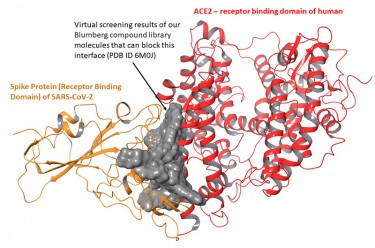Research Projects for COVID-19
COVID-19 research underway at the Blumberg Institute:
COVID-19 infection of the human heart The lab of Richard G. Pestell, MD, PhD, FCRP
Dr. Pestell and colleagues are studying tissue from the hearts of patients who died from COVID-19. The researchers are analyzing the damage done by the virus and how that contributed to patients’ deaths. They have been conducting digital spatial profiling to examine the role of more than 1,000 genes and have used these new technologies to identify the RNA and protein in cardiac cells from cadavers.
In a study that Dr. Pestell and his team presented this spring at the annual meeting of the American Association for Cancer Research, they reported the presence of COVID-19 virus proteins and RNA in cardiac myocytes. These studies showed distinct inflammatory pathways are activated in the hearts infected by COVID-19 in different patients.
The authors considered, “These data may explain factors contributing to both the death and perhaps cardiac morbidity associated with SARS-CoV-2 infection.”
The researchers’ goal, Dr. Pestell explains, is to characterize the immune response in the hearts of the patients studied to use existing, approved drugs to minimize the cardiac damage caused by COVID-19.

Image from the lab of John Kulp, Ph.D.
Therapeutics to manage and understand SARS-CoV 2 virus and Covid 19.
Iminovirs The Labs of Jinhong Chang, MD, PhD and Yanming Du, PhD
We now have evidence that a family of drugs we discovered, iminosugar ER glucosidase inhibitors, significantly reduces the replication of SARS-CoV (the cause of SARS) in vitro in cultured cells, at concentrations where no cytotoxicity is observed. ER glucosidase inhibitors involve two distinct targets against coronaviruses. The mechanism of action of our imino sugars against SARS-CoV leads us to believe the drug will be active against SARS-CoV-2, the viral cause of COVID-19.
Our drug hits the SARS-CoV at two of steps in its life cycle which are essential, and both are also used by SARS-CoV-2. Our drug inhibits the viral spike (S) glycoprotein folding which depends upon ER glucosidase I & II. SARS CoV and SARS CoV-2 Spike proteins both have more than 20 N-glycosylation sites. Our drug also inhibits the viral “receptor”, which is N-glycosylated, so that entry of the virus to cells is reduced.
The labs of Dr. Jinhong Chang and Dr. Yanming Du wish to determine if these iminosugars will be active against SARS-COV-2, and study the mechanism-based feasibility of further developing into COVID-19 therapeutic candidates.
Discovery of direct-acting antivirals that target SARS-Cov-2 The Lab of John Kulp, PhD
SARS-Cov-2 depends on a virus specific proteins. Two of them are the main protease (NSP5) and the SPIKE protein (S). Multiple crystal structures of the NSP5 and S have determined and reported. The laboratory of John Kulp, Ph.D. has computer-assisted models to screen our compound library (and other libraries) for small molecules that bind these vital viral proteins. Once candidate compounds have been identified by this virtual screen, he wishes to test them for authentic activity against SARS-Cov-2.
Minibodies to block SARS Cov-2 The Lab of Yizeng Yang, MD, PhD
The lab of Yizeng Yang, M.D., Ph.D., is synthesizing mini-antibody mimetics intended to prevent SARS-CoV 2 from binding to and attacking target cells. These would serve as artificial “antibodies.” Dr. Yang can produce these mimetics in the lab but wishes to have hem tested for their ability to actually block authentic virus.
Harnessing innate immunity control for prevention and treatment of SARS-CoV-2 infection The Lab of Ju-Tao Guo, MD
Dr. Guo and colleagues recently reported their discovery that a cellular protein, LY6E, can be induced by interferons and render cells resistant to the infection of all the known human coronaviruses, including the currently pandemic SARS CoV-2 (bioRxiv preprint). Further understanding its expression and mechanism to block the entry of viruses into their target cells as well as its interaction with other cellular restriction factors will facilitate the efforts to discover therapeutics that harness these host cellular defense proteins for the prevention and treatment of COVID-19 and potential future coronavirus epidemics.